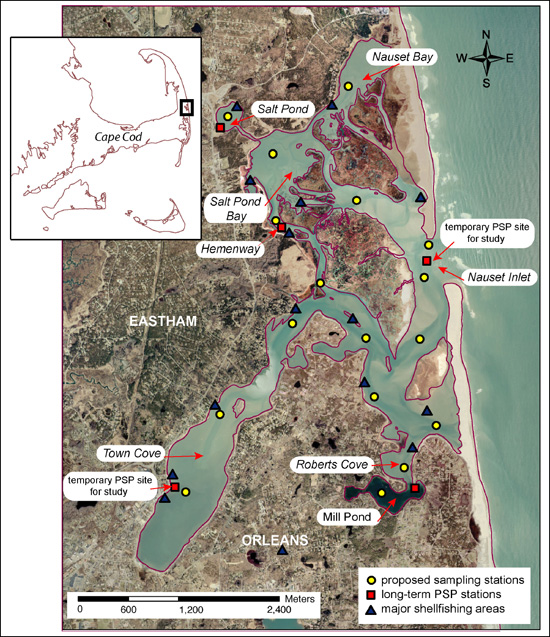Toxic Alexandrium blooms in the Nauset Marsh System
The Nauset Marsh System (NMS) is a unique and valuable resource located in an area with significant and growing development pressures. Shellfishing is a major commercial and recreational activity, but over the past decade, that resource has been impacted on virtually an annual basis by outbreaks of paralytic shellfish poisoning (PSP), some of which have been at extreme levels of toxicity. PSP is a recurrent problem in areas “downstream” of the NMS, and thus export of cells from the system is a concern as well. The overall goal of this project is to characterize the distribution and dynamics of Alexandrium fundyenseblooms within the NMS and adjacent coastal waters and to use this information to guide policy decisions about resource monitoring and utilization.Specific objectives are to:
- Determine the spatial and temporal variability of A. fundyense blooms in the salt ponds, channels, inlet, and adjacent coastal waters of the NMS as an indication of the relative importance of in situ growth within the system vs. advection from outside
- Map the distribution and abundance of A. fundyense resting cysts within the NMS to determine the potential for local initiation of blooms
- Determine the genetic composition of Alexandrium populations within the NMS and adjacent coastal waters to assess the extent of inter-population mixing
- Analyze historical and new PSP records from the NMS to determine the patterns of shellfish toxicity in the context of regional outbreaks and hold a workshop to assist resource managers in the formulation of effective policies that can protect public health while maximizing the use of shellfish resources within the NMS.
Cysts and motile cell distributions will be mapped using methods employed extensively by the PIs in other studies of Alexandrium. Undisturbed sediment samples will be collected, sectioned, and processed using sonication and sieving, and cysts will be stained with primuline and counted using epifluorescence microscopy. For determination of Alexandrium cell distributions, ~ 400 samples will be collected within the NMS and adjacent coastal waters. Samples will be sieved and preserved for cell counts using an A. fundyense-specific oligonucleotide probe. The genetic identity of A. fundyense cells will be assessed via microsatellite markers and the diversity of the resulting genotypes analyzed using population genetics techniques. Shellfish toxicity records will be acquired from the Massachusetts Division of Marine Fisheries (DMF). Analysis will include basic statistics of the mean, maximum, first date of occurrence, and the duration of events at each monitoring site. In addition, the relationship between the shellfish monitoring sites will be statistically tested for coherence to determine if the onset and decline of toxicity at each station occurs at the same time. A workshop will be convened to disseminate results to state and local managers, shellfishermen and other parties and to discuss recommendations for management.
The Nauset Marsh System has a long history of PSP, but little is known about the bloom dynamics of the causative organism A. fundyense within that economically and socially important system. It is time for a comprehensive re-examination of the system, particularly because the characteristics of the PSP problem have changed in a dramatic and negative manner over the last two decades and because the NMS lies upstream of additional resources that would be impacted by toxic cells exported from the system. This study will therefore document the distribution and dynamics of A. fundyense cells within the NMS and adjacent waters and the possible sources and fate of those cells. We will also examine the genetic heterogeneity of Alexandrium as an indication of the extent of mixing within the system and the extent to which cells are imported and exported to adjacent coastal waters and downstream resources. This information is of value to managers and public health officials, as knowledge of red tide dynamics within the system may lead to a change in the present policy of closing the entire NMS when toxicity is detected within it. Furthermore, knowledge of the export of cells to coastal waters can improve monitoring capabilities and the safety of shellfish in downstream areas. This study fits with the strategic goals of Sea Grant for the management of shellfish resources using molecular techniques to differentiate populations with the ultimate goal of public health protection.
Relevant Publications
Anderson, DM, 1997. Bloom dynamics of toxic Alexandrium species in the northeastern United States. Limnol. Oceanogr. 42(5, part 2), 1009-1022.
Anderson, DM, BA Keafer, DJ McGillicuddy, MJ Mickelson, KE Keay, PS Libby, JP Manning, CA Mayo, DK Whittaker, JM Hickey, R He, DR Lynch, and KW Smith, 2005. Initial observations of the 2005 Alexandrium fundyense bloom in southern New England: General patterns and mechanisms. Deep-Sea Res. II 52(19-21): 2856-2876.
Anderson, DM, DM Kulis, GJ Doucette, JC Gallagher, E Balech, 1994. Biogeography of toxic dinoflagellates in the genus Alexandrium from the northeastern United States and Canada. Mar. Biol. 120:467-478.
Anderson, DM, DM Kulis, BA Keafer, KE Gribble, R Marin, and CA Scholin, 2005. Identification and enumeration of Alexandrium spp. from the Gulf of Maine using molecular probes. Deep-Sea Res. II 52(19-21): 2467-2490.
